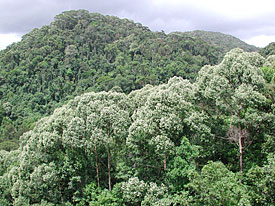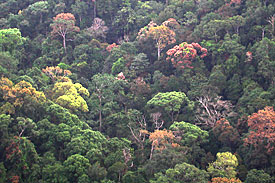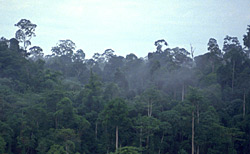Press release from October 29th, 2009
ERC provides millions for biodiversity research
Scientists research coexistence in species-rich communities
Leipzig. A group of researchers led by ecological modelling experts Dr Thorsten Wiegand and Dr Andreas Huth and funded by the European Research Council (ERC) has begun work at the Helmholtz Centre for Environmental Research (UFZ) in Leipzig. The researchers will receive over EUR 2 million in research funding from the ERC over the next five years to investigate the composition and dynamics of species-rich communities. Advances in this area are important for biodiversity conservation in connection with climate and land use change, and for calculating carbon balances.

Shorea trapezifolia in bloom. S. trapezifolia is one of the most dominant canopy species preferring well drained middle and lower hill -slope habitats. It is one of the annually flowering Shorea species which co-occurs with mast-flowering Shoreas. S. congestiflora, an annually flowering species is more dominant at lower altitudes than at Sinharaja - a vicariant of S. trapezifolia.
Photo: Nimal Gunatilleke, Universität Peradeniya

Canopy of lowland hill dipterocarp forest in Sinharaja taken from the top of a lowland hill - Sinhagala (about 800m asl). It shows different species in different stages of leaf flushing (light green) and early fruiting (pinkish - red) stages but none in the picture in bloom.
Photo: Nimal Gunatilleke, Universität Peradeniya

Dipterocarpacea forest in Malaysia. This is the most important forest type in Southeast Asia. The project is also going to deal with this forest type.
Photo: Dr. Andreas Huth
The European Research Council awards the ERC Advanced Grant to provide established, innovative and active researchers an opportunity to pursue frontier research of their choice. The formation of the ERC puts Europe’s top researchers into direct open competition for the first time. The first call of the ERC Advanced Grants in life sciences received applications from 766 scientists worldwide. Seventy-eight projects were awarded on the sole criterion of excellence, with only 11 being selected from Germany.
The UFZ had already received a Starting Grant from the ERC in 2008. The group of new researchers led by microbiologist Prof. Lorenz Adrian is researching bacteria that convert chlorinated aromatic hydrocarbons. This makes the UFZ the first Helmholtz Centre to have been awarded both a Starting Grant and an Advanced Grant from the ERC.
Over the coming years, the researchers in Thorsten Wiegand and Andreas Huth’s team will be investigating why so many species are able to coexist in ecological communities like forests. Their SPATIODIVERSITY project (‘Towards a unified spatial theory of biodiversity’), combines high computing power with the latest methods of spatial pattern analysis, individual-based forest simulation models and model selection theory to understand the factors and processes that govern the composition and dynamics of species-rich communities.
The scientific approach is based primarily on information contained in the spatial distribution of species, which has not yet been fully exploited. "To accomplish our goal, we take a radically different approach than previous attempts and adopt a spatially explicit perspective that will allow us to take significant steps towards a ‘Unified Spatial Theory of Biodiversity’," explains Thorsten Wiegand. The researchers will be using one of the most extensive data sets currently available in the field of ecology - data from large, long-term research plots in tropical forests that are home to several hundred tree species and over 100,000 individual trees. The trees on these plots are surveyed every five years.
"The project consists of three components," explains Thorsten Wiegand. "In the first stage we will be using the latest spatial pattern analysis techniques to quantify the highly complex spatial structures in tropical forests." "At the same time," Andreas Huth adds, "We will be putting together a raft of individual-based, spatially explicit forest simulation models, ranging from simple ‘neutral’ models to detailed, process-based simulation models for forests. Our many years of experience of working with forest models such as FORMIND and FORMIX3 will be an advantage here." In the critical third step, the researchers will be applying model selection techniques to discover which of the simulation models best reflect the observed spatial structures. One of the particular challenges of the project is the high level of complexity of the spatial structures and interactions. The extensive analyses can only be successfully tackled in a large project and require a considerable amount of computing power.
Close partners of the project are Prof. Savitri Gunatilleke and Prof. Nimal Gunatilleke (University of Peradeniya, Sri Lanka Plot), and Prof. Sean Thomas (University of Toronto, Malaysia Plot). The project is being supported by Prof. Steven Hubbell, Dr Richard Condit and Dr Stuart Davis, who head the network of research plots in tropical forests organised by the Smithsonian Tropical Research Institute. There are plans to involve more researchers in the project.
More information
PD Dr. habil. Thorsten Wiegand
Telephone +49 (0)341 2351714
PD Dr. habil. Thorsten Wiegand
Dr. habil Andreas Huth
Telephone +49 (0)341 2351719
Dr. habil Andreas Huth
or
Helmholtz Centre for Environmental Research (UFZ)
Press office
Tilo Arnhold
Telephone +49 (0)341 2351269
presse@ufz.de
Publications
Wiegand, T., Martínez, I., Huth, A. (2009):
Recruitment in tropical tree species: revealing complex spatial patterns
The American Naturalist (Nol. 174, No. 4, E-Article October 2009)
http://dx.doi.org/10.1086/605368
T. Wiegand, S. Gunatilleke, N. Gunatilleke, and A. Huth (2007):
How individual species structure diversity in tropical forests
Proc.Nat.Acad.Sci.USA 104:19029-19033
http://dx.doi.org/10.1973/pnas.0705621104
Links
Towards a Unified Spatial Theory of Biodiversity
www.thorsten-wiegand.de/towi_ERC.html
New method for measuring biodiversity - How individual species help structure the biodiversity of tropical rainforests (Press release from February 15th, 2008)
www.ufz.de/index.php?en=15991
Species associations in a heterogeneous Sri Lankan Dipterocarp forest - Spatial patterns in tropical forests can help to understand their high biodiversity (Press release, September 25th, 2007)
www.ufz.de/index.php?en=15138
European Research Council (ERC)
erc.europa.eu
At the Helmholtz Centre for Environmental Research (UFZ) scientists research the causes and consequences of far-reaching environmental changes. They study water resources, biological diversity, the consequences of climate change and adaptation possibilities, environmental and biotechnologies, bio energy, the behaviour of chemicals in the environment and their effect on health, as well as modelling and social science issues. Their guiding research principle is supporting the sustainable use of natural resources and helping to secure these basic requirements of life over the long term under the influence of global change. The UFZ employs 930 people at its sites in Leipzig, Halle and Magdeburg. It is funded by the German government and by the states of Saxony and Saxony-Anhalt.
The Helmholtz Association helps solve major, pressing challenges facing society, science and the economy with top scientific achievements in six research areas: Energy, Earth and Environment, Health, Key Technologies, Structure of Matter, Transport and Space. With 28,000 employees in 15 research centres and an annual budget of around EUR 2.4 billion, the Helmholtz Association is Germany’s largest scientific organisation. Its work follows in the tradition of the great natural scientist Hermann von Helmholtz (1821-1894).
